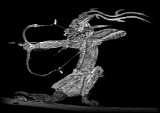
Asian Traditional Archery Research Network (ATARN)
A1, Cloudridge,
30, Plunkett’s Road,
The Peak, Hong Kong.
Fax: (852) 2808-2887
email: srselby@atarn.org
May 2003
Dear All,
The Asian Archery Festival originally scheduled for May 2003 has been postponed to October 25 - 27 to allow the region to get clear of the Sars outbreak. Please check out the current programme, and keep a look-out for up-dates.
Meanwhile, the Hong Kong Museum of Coastal Defense plans to open its Asian Archery Exhibition to the public according to the original schedule at the end of this month (but with the opening ceremony delayed until October). I hope that in my next newsletter, I can bring Members a special preview of the exhibit - the fourth Museum exhibition devoted to traditional archery in the World.)
Tom Winter Associate Professor of Classics, University of Nebraska, writes:
"I now have my own Csaba Grozer old Scythian bow. I learned of it from your site; it occurred that you might be interested in some feedback.
I teach Latin and Greek at the University of Nebraska, and I wanted a reproduction for many reasons, including for my lectures on the Odyssey. Greeks, of course, used "Scythian" and "archer' interchangeably; In Athens, Scythian archers accompanied the equivalent of police, and any bow in a Greek vase painting would basically look the same as, or essentially - be -a Scythian composite recurve bow.
So I had to have one! (Another reason: the Scythian has the least mass at the tips of the types available at the Grozer website. This should be a factor towards getting the work of the draw into the momentum of the arrow.)
The draw: informed by your site, I experimented with the Mongol release, using some old fiberglass youth bows. I did decide that three fingers would pull more bow for me than my thumb ever would, but am a better informed archer for the experience. I recently switched to left-hand shooting. A daily diet of 100 arrows a day weather permitting, coupled with dry-drawing indoors in the inclement weather, have made my left draw-fingers noticeably thicker than the same fingers on the right hand. I think this has been essential to good shooting. Someone said it before in one of the archery classics: it's not the weight you can draw; it's the weight you can loose. And my drawing thumb would doubtless profit from the same training.
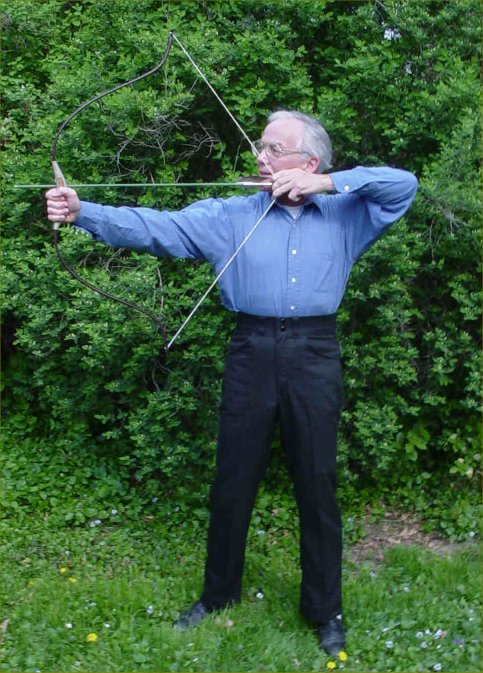
Tom Winter with his Scythian Bow (© Tom Winter, 2003)
But back to my Scythian: Last night, I was doing very well, plunking 17 of 22 arrows into a 16" circle at 24 yards with a favorite 45 lb longbow. (For me, this is good.) I switched to my old Scythian and got a surprise: with the 45 lb Scythian, aiming as with the longbow, my arrows were going about 20" higher. Using the Scythian at the same weight, my aim needed more gap between the pile and the gold. This done, I then put 17 arrows in a row into the 16" circle. Missed next three, ended with 19 of 22 into the 16" circle. Ruined two by hitting them. Now that I can group my arrows, I must stop shooting so many at a time!
Sum: my Grozer "old Scythian" is faster than my favorite longbow of the same draw weight, and at least as accurate, or more. My arrow stopper is 6 layers of carpet draped over a wooden sawhorse, and set in front of rising ground.
All best wishes, Tom Winter."
In 1738, The Manchu emperor Qianlong ordered a division of his Manchu bannermen to defend the border of China in Xinjiang where his troops had been fighting continued campaigns against the Muslim Uighurs. The troops that he dispatched came from the Xibe (pronounced "shee-ber") group, and were directly descended from the Ruzhen who founded the Jin Dynasty in China between 1115 and 1234.
The Xibe Manchus travelled with their families, enduring an arduous trek lasting three years, until they finally reached Ili (Yining) on the border of modern-day Khazakhstan. Although Ili is surrounded by the forbidding Tian Shan Range and the deserts of Central Asia, the Ili river plain is fertile and the climate is so mild that they can grow rice there. (The Ili valley is thought to be the place from which all domesticated apples in the world originated, and the last descendants of the famous ‘blood-sweating’ horses can be found high in the surrounding valleys.)

The Tian Shan Mountain seen from the air as you approach Ili, Xinjiang
Originally, the bannermen were to be posted there for thirty years; but when the period ended, their request to return to their homeland was refused. So there they settled, established an ancestral temple and built up a community at Chapchal (Chabucha’er).
The Xibe community remains at Ili until today – indeed it is the only Manchu community in China which preserves the original Manchu written and spoken language. Spoken and written Manchu has died out among the remaining Manchus in north-east China. Today, the Xibe of Chapchal have a Manchu language local newspaper, a Manchu language primary school syllabus (with textbooks in Manchu), and even a Manchu language broadcasting station.

Manchu language weekly newspaper, 'Chapchal Serkhin' and Manchu primary
school textbooks.
Through the Centuries, the Xibe of Chapchal maintained the proud Manchu archery tradition. Every year in May, they celebrate the day that they completed their arduous journey from the Capital to Ili, and hold an archery competition. Gradually, however, with the loss of the traditional Manchu bows, they changed to using Western archery equipment. Only a few old men continue to shoot with fire arrows and whistling arrows to mark the festival. Modern Xibe shoot with compound bows or competition recurves.
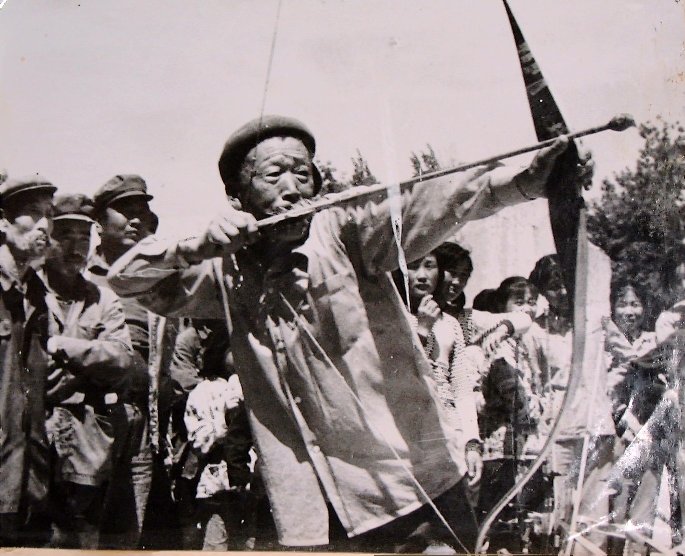
Traditional Xibe archer with a whistling arrow in the 1980s
But archery prowess has never deserted the Xibe. Even today, when a boy is born, a miniature bow and arrow are hung over his cot. Children – boys and girls – learn to shoot young, and every province in China now has at least one archer from the Xibe minority on its provincial team.
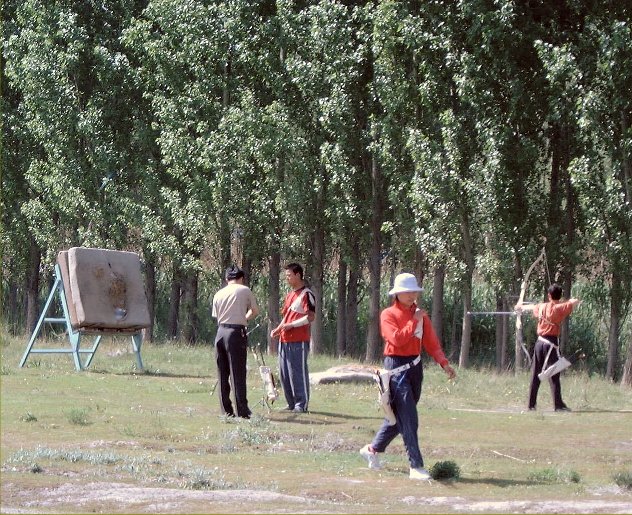
Young Xibe archers practicing
In May 2003, I visited the Xibe at Chapchal and interviewed them about their archery tradition. I presented them with a photocopy of Naran Changgiun’s ‘Shooting the Target’ – a book on archery written in Manchu at the start of the Qing Dynasty, the last remaining copy of which is now kept at the Toyobunko Library in Tokyo. They were amazed and delighted to have it, and vowed that it would be re-printed in their local newspaper.
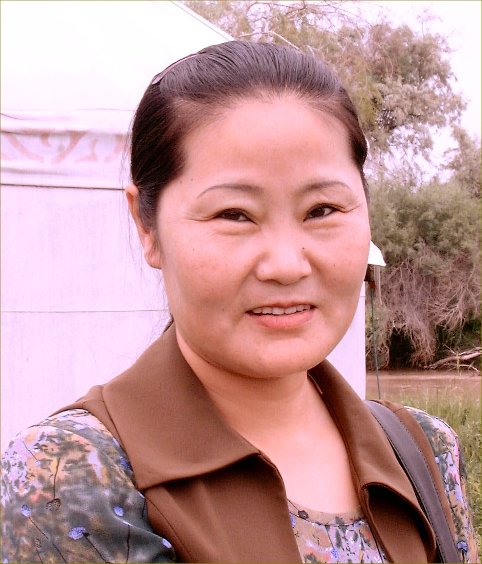
Chapchal archery coach, Ms Jin.
They have a small local museum of Manchu culture in which they had previously had an old bow on display (until it was clumsily destroyed by a visiting newspaper reporter!) Last year, I sent them an original old Manchu bow to replace it.
Last week, I received a letter from Mr Xu Kaicai – former Chinese national archery coach – who had accompanied me to Chapchal last year: the Xibe have applied to the Central People’s Government to introduce archery into the primary and secondary school syllabus. After consultation with the National Archery Association, it has been proposed that their request be accepted provided that they also include traditional Manchu archery in the syllabus. They will be sent ten of the reproductions of Manchu bows provided through ATARN and generously funded by the Rotary Club of Hong Kong North.
|
|
(Signed) (Stephen Selby) |